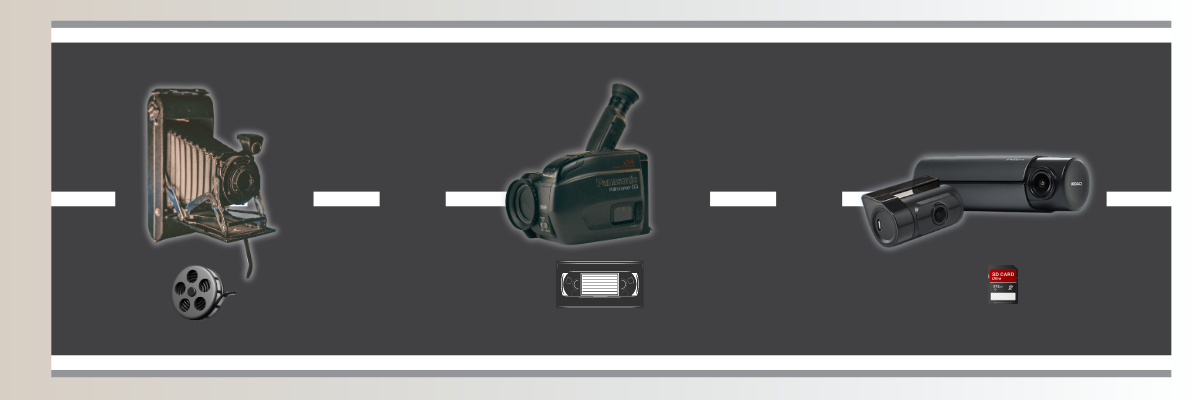The Evolution of Dashcams – How Today’s Technology Came to Be: Part 1
Photo by Jason Jarrach on Unsplash
Photo by Leonard Reese on Unsplash
Picture yourself driving down a crowded city street when all of a sudden, a dramatic car accident occurs right in front of you. Luckily, your dashcam records every little thing, offering vital proof that could help you avoid a legal disaster. How did dashcams transform from bulky, specialized gadgets to the sleek, high-tech tools we now depend on in vehicles? Let’s discover the captivating evolution of dashcams from their initial beginnings to the sophisticated technology we rely on today.
Early Beginnings
While the modern dashcam is a recent innovation, its roots stretch much further back in history. The first known dashcam-like footage was captured all the way back in 1903 when Ohio filmmaker William Harbeck mounted a hand-crank camera on a streetcar to capture scenes of Western Canada. This inventive mindset continued into the 1930s, when H.C. Fairchild developed a windshield-mounted camera aimed at helping police in capturing traffic violations. By the 1960s, dashcams were becoming more common in police vehicles to combat traffic violations, and in 1988, the first full police car chase was captured from start to finish in Ohio. These early experiments laid the foundation for dashcams as we know them today.
The Rise to Popularity
Dashcams started to gain popularity with the public in the early 2000s, particularly in Japan and Russia.
In Japan, with increasing concerns about road safety, some innovators have begun to see dashcams as a crucial tool for recording journeys, preventing fraud, and offering proof in case of accidents. Despite early dashcam being bulky and costly, early adopters viewed them as essential for self-defense in a congested road system.
In Russia, dashcams quickly became indispensable due to high accident rates and widespread issues like insurance fraud and police corruption. They provided critical evidence, helping drivers prove their innocence and prompting the government to encourage their use to reduce false claims and improve road safety.
The dramatic footage captured by dashcams such as car crashes to meteor shower, brought them into the global spotlight. With improvement in technology and more affordable pricing, dashcams transformed from niche gadgets into essential accessories for drivers worldwide.
Video courtesy of dashcamworld
Technological Breakthroughs
The advancement in dashcam was marked by several significant technological breakthroughs. With introduction of GPS, dashcams could now record precise location data, adding an extra layer of detail to footage. Night vision technology made it possible to capture clear images even in low-light conditions, addressing a critical need for visibility during nighttime driving.
Another major advancement was addition of Wi-Fi connectivity. This allowed users to upload footage to the cloud, making it easy to access and share videos from their smartphones or computers. Leading brands in the industry quickly adopted these innovations, enhancing the functionality and appeal of their dashcam models, like IROAD FX2 PRO which integrates Wi-Fi connectivity and advanced night vision. As these technologies became more refined, they made dashcams more versatile, contributing to their growing popularity among drivers.
Dashcams in the Digital Age
The emergence of smartphones and digital technology brought dashcams into a new era. The capability to connect dashcams with smartphones transformed the way they are utilized. Drivers now have the ability to watch live recordings, control settings, and view saved videos from their smartphones, providing an added level of ease and authority.
With the progression of technology, dashcams became more affordable for regular drivers due to lower costs. Many models now come with standard enhanced features like high-definition recording and advanced collision detection. Brands that focused on user-friendly experiences helped lead this transformation, making dashcams more than just specialized gadgets—they became a common accessory in vehicles worldwide, with safety and convenience at the forefront.
The Modern Dashcam
Today’s dashcams showcase the amazing advancements in technology. Modern dashcams go beyond just recording videos by offering features such as HD video recording, collision warnings, and driver assistance alerts, providing important tools to improve road safety.
Brands like IROAD are spearheading the integration of these advanced capabilities into their products. IROAD’s models are well known for their top-notch recording quality and advanced driver assistance systems that keep drivers informed and safe during all trips.
Conclusion
From their early beginnings to their current state of sophistication, the journey of dashcams is a story of innovation and progress. These devices have evolved from bulky, niche gadgets to essential components of vehicle safety and security. In the second and final part of our series, we’ll delve into the exciting emerging trends and innovations poised to shape the next generation of dashcam technology. Stay tuned!




